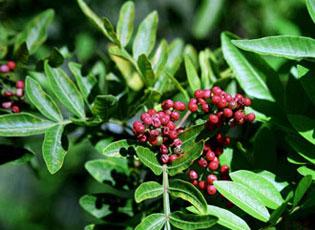Schinus terebinthifolius Raddi (ITIS)
Brazilian peppertree, Christmas berry, Florida holly, broad leaf pepper tree
South America (Hight et al. 2002)
1840s (Hight et al. 2002)
Introduced as an ornamental (Hight et al. 2002)
Forms dense, monospecific stands that crowd out native species; possibly produces chemicals that inhibit the growth of native species (Meyer 2011)

Brazilian peppertree, fruit clusters
Photo by Stephen D. Hight; USDA, Agricultural Research Service
Spotlights
Distribution / Maps / Survey Status
All Resources
Selected Resources
The section below contains highly relevant resources for this species, organized by source.
Council or Task Force
Partnership
Federal Government
International Government
State and Local Government
Academic
Hight, S.D., J.P. Cuda, and J.C. Medal. 2002. Brazilian Peppertree. In: R. Van Driesche et al. (Eds.), Biological control of invasive plants in the eastern United States (FHTET-2002-04). Morgantown, West Virginia: U.S. Forest Service Forest Health Technology Enterprise Team.
Integrated Taxonomic Information System. Schinus terebinthifolius. [Accessed Mar 24, 2023].
Meyer, R. 2011. Schinus terebinthifolius. In: Fire Effects Information System. U.S. Department of Agriculture, Forest Service, Rocky Mountain Research Station, Fire Sciences Laboratory.
